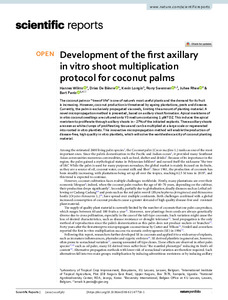| dc.contributor.author | Wilms, H. |
| dc.contributor.author | De Bièvre, D. |
| dc.contributor.author | Longin, K. |
| dc.contributor.author | Swennen, R. |
| dc.contributor.author | Rhee, J. |
| dc.contributor.author | Panis, B. |
| dc.date.accessioned | 2022-09-21T10:01:50Z |
| dc.date.available | 2022-09-21T10:01:50Z |
| dc.date.issued | 2021 |
| dc.identifier.citation | Wilms, H., De Bièvre, D., Longin, K., Swennen, R., Rhee, J. & Panis, B. (2021). Development of the first axillary in vitro shoot multiplication protocol for coconut palms. Scientific Reports, 11(1): 18367, 1-10. |
| dc.identifier.issn | 2045-2322 |
| dc.identifier.uri | https://hdl.handle.net/20.500.12478/7789 |
| dc.description.abstract | The coconut palm or “tree of life” is one of nature’s most useful plants and the demand for its fruit is increasing. However, coconut production is threatened by ageing plantations, pests and diseases. Currently, the palm is exclusively propagated via seeds, limiting the amount of planting material. A novel micropropagation method is presented, based on axillary shoot formation. Apical meristems of in vitro coconut seedlings are cultured onto Y3 medium containing 1 µM TDZ. This induces the apical meristem to proliferate through axillary shoots in ~ 27% of the initiated explants. These axillary shoots are seen as white clumps of proliferating tissue and can be multiplied at a large scale or regenerated into rooted in vitro plantlets. This innovative micropropagation method will enable the production of disease-free, high quality in vitro plantlets, which will solve the worldwide scarcity of coconut planting material. |
| dc.format.extent | 1-10 |
| dc.language.iso | en |
| dc.subject | Coconuts |
| dc.subject | Plantations |
| dc.subject | Micropropagation |
| dc.subject | Seedlings |
| dc.subject | Pests of Plants |
| dc.title | Development of the first axillary in vitro shoot multiplication protocol for coconut palms |
| dc.type | Journal Article |
| cg.contributor.crp | Roots, Tubers and Bananas |
| cg.contributor.affiliation | Katholieke Universiteit, Leuven |
| cg.contributor.affiliation | International Institute of Tropical Agriculture |
| cg.contributor.affiliation | National Agrobiodiversity Center, Korea |
| cg.contributor.affiliation | Bioversity International |
| cg.coverage.hub | Eastern Africa Hub |
| cg.researchtheme | Biotech and Plant Breeding |
| cg.identifier.bibtexciteid | WILMS:2021 |
| cg.isijournal | ISI Journal |
| cg.authorship.types | CGIAR and advanced research institute |
| cg.iitasubject | Agronomy |
| cg.iitasubject | Biodiversity |
| cg.iitasubject | Crop Husbandry |
| cg.iitasubject | Farming Systems |
| cg.iitasubject | Food Security |
| cg.iitasubject | Pests of Plants |
| cg.iitasubject | Plant Breeding |
| cg.iitasubject | Plant Production |
| cg.iitasubject | Tissue Culture |
| cg.journal | Scientific Reports |
| cg.notes | Open Access Article; Published online: 15 Sep 2021 |
| cg.accessibilitystatus | Open Access |
| cg.reviewstatus | Peer Review |
| cg.usagerightslicense | Creative Commons Attribution 4.0 (CC BY 0.0) |
| cg.targetaudience | Scientists |
| cg.identifier.doi | https://dx.doi.org/10.1038/s41598-021-97718-1 |
| cg.iitaauthor.identifier | Rony Swennen: 0000-0002-5258-9043 |
| cg.futureupdate.required | No |
| cg.identifier.issue | 1 |
| cg.identifier.volume | 11 |
| cg.contributor.acknowledgements | We want to acknowledge the Philippine Coconut Authority (PCA) and more specifically Dr. Ramon Rivera for providing us with the plant material that was used in this project, Sibelco and their staff in Dessel and more specifically Bart Wilms and Helen Hamaekers for providing us with the scanning electron microscopy pictures and Natalia Fanega Sleziak for proofreading the document. This study was carried out with the support of the “Research Program for Agricultural Science & Technology Development (Project No.PJ012225)” of the International Cooperative Research Project in National Institute of Agricultural Sciences, Rural Development Administration, Republic of Korea. This study was carried out with the support of the Directorate-general Development Cooperation and Humanitarian Aid, Belgium (DGD) for the financial support of the project ‘Safeguarding vegetatively-propagated crop diversity to nourish people now and in the future’. |

